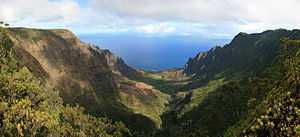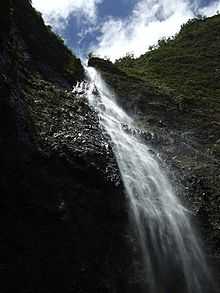Kalalau Valley
Coordinates: 22°10′48″N 159°39′13″W / 22.18000°N 159.65361°W

The Kalalau Valley is located on the northwest side of the island of Kauaʻi in the state of Hawaiʻi. The valley is located in the Nā Pali Coast State Park and houses the beautiful Kalalau Beach. The Nā Pali Coast is very rugged and is inaccessible to automobiles. The only legal ways to access the valley are by kayak or by hiking the Kalalau Trail.
The valley is renowned for its natural beauty; it is surrounded by lush cliffs more than 2,000 feet (610 m) high. The valley bottom is broad and relatively flat, with an accessible region about 2 miles (3.2 km) long and 0.5 miles (0.80 km) wide. The abundant sun and rain provides an ideal environment for flora and fauna. Many native Hawaiians lived in the valley into the 20th century, farming taro from a vast complex of terraced fields. Today, its designation as a state park forbids anyone from residing there.
Access to Kalalau Valley
Since the Nā Pali Coast is too steep for any motorized vehicles, all access to the valley is by boat or foot, with the exception of emergency helicopter landings. Kayaks are a popular way of visiting the valley, although sea conditions can make this dangerous during the winter. Hiking the Kalalau Trail is also popular, but the trail is about 11 miles (18 km) long, quite strenuous, and can be dangerous at parts.
Access to the Kalalau Valley is controlled in the name of conservation. A limited number of permits are issued for camping in Kalalau Valley every year by the Hawai'i Department of Land and Natural Resources (DLNR). Anyone wishing to hike beyond Hanakāpīʻai valley must have a permit for staying in Kalalau Valley overnight. A total of sixty overnight permits are issued for each night. Permits must generally be sought as early as 6 months in advance of travel.
The valley is visible from the Kōkeʻe State Park, which is accessible by road from the west side of the island. It is rumored that there is a trail accessing the valley from Kōkeʻe, however all possible routes appear to be very dangerous and some people are suspected to have fallen to their deaths trying to find them.
Ecology
The valley is home to many rare species, including the endangered plant Dubautia kalalauensis which was named for the valley and is found nowhere else in the world.[1] Other endemics include the endangered Schiedea attenuata.[2]
Life in Kalalau Valley

The natural beauty and relative isolation are the major attractions of the valley. Legal campers stay in the designated camping area within roughly 300 feet (91 m) of the beach. There is a small waterfall in this area that is used for bathing and washing dishes.
At one end of the beach is a stream that is also used for fresh water. All the streams are contaminated with leptospirosis, a bacteria that is transmitted from the urine of infected rodents. It is transmitted from the water into open cuts or mucous membranes. Symptoms occur from 5 days to 2 weeks after exposure and include sudden onset of fever, body aches, malaise. Treatment is with doxycycline 100 mg twice day. It is recommended that you treat water with iodine, and the story that stomach acid kills the leptospirosis does not take into account the fact that the bacteria is contracted via the membranes of the mouth and throat.

Residents
In spite of the efforts of the state of Hawaiʻi, many people illegally hike the Kalalau Trail and even live in the valley. These long-term campers live the lifestyle of Naturalists and are suspected by some to cause serious harm to the ecological balance of the valley by their waste and propagation of introduced species.
Some of these inhabitants contribute to the health of the valley by collecting waste, practicing leave no trace ethics, and tending to the trails which require constant maintenance. These stewards of the Nā Pali believe that the valley can return to a state of self-sufficiency with careful and sustainable use of the valley's abundant resources. Some of these people argue that since permits are only available for 5 nights, there is not enough time to fully enjoy the valley. It takes at least 1 day for the rigorous 11 miles (18 km), leaving only 3 days to explore the valley and beaches. There are stories of people who hike in and decide to stay indefinitely, due to the beauty and serenity that they find in the Kalalau Valley.
The residents of the valley sometimes come into conflict with authorities charged with enforcing the law. The DOCARE officials make biannual raids of the valley, sometimes slashing and burning camp sites and illegal farms. Visitors who do not have a permit are issued citations that require a court appearance and a fine of up to $500 for a first offense.
Destruction of terraced gardens
The magnificent and historical terraced gardens in the Kalalau Valley are being threatened and destroyed by the introduced and invasive trees. These trees created an extensive underground root network which quickly invaded the traditional rock walls of the terraces. Also, since these trees are introduced species, they are not suitable for the heavy Pacific Ocean winds that frequent the valley on a daily basis. The trees then fall and topple the rock walls causing permanent damage.
The origin of the trees is disputed. Some argue that they were planted by the DLNR after the Hawaiian people abandoned the valley and it was decided to turn the valley into a popular tourist destination. The DLNR felt that tourists would like a forested canopy instead of bare land which was previously used as cattle pasture and taro plots. However, others note that the last private owners of the valley, the Robinson family, likely planted some of the trees there to provide shade for cattle kept there after the Hawaiians left.
Still others contend that the terraces were initially destroyed by the Robinson's cattle after the last Hawaiians left the valley in the early 1900s. The foraging cattle destroyed many terraces causing heavy erosion. The DLNR drop-seeded Java Plum trees (Syzygium cumini) to prevent erosion of the valley's topsoil. The roots grow around the stone terraces and when they fall, dislodge the rocks.
Helicopters
There is also concern among visitors that the use of helicopters in the area is disturbing. Helicopters cause noise pollution that can be heard for miles. After reaching the end of the trail, hikers expect a quiet place to reflect on the majesty of the Nā Pali. Instead, they are faced with constant helicopter buzz from sun up to sun down. Many helicopters fly below legal limitations to "get a closer view." This practice causes considerable disturbance to those wishing to enjoy the Nā Pali, and contributes to erosion of the land and rock fall.
Management of Kalalau Valley
Since the valley is a part of the Nā Pali Coast State Park, the DLNR is responsible for its maintenance and preservation. Some have criticized the DLNR for their inability to manage the Nā Pali Coast, although others note that many Hawaiʻi parks suffer from a chronic lack of funding.
References
- ↑ USFWS. Determination of endangered status for 48 species on Kauai and designation of critical habitat; Final rule. Federal Register April 13, 2010. pg 18965.
- ↑ Schiedea attenuata. The Nature Conservancy.